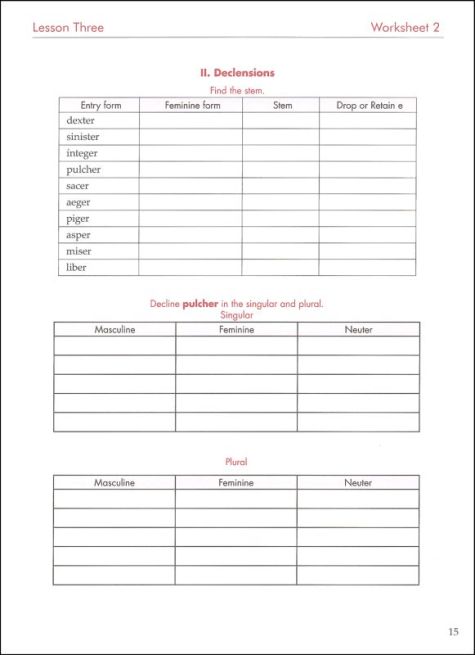I love Latin. Ever since my highschool trip to Rome, where Latin phrases adorn the walls of churches, I have admired the logic, beauty, and timelessness of the Latin language.
But I also know that when we consider the myriad of subjects and activities we wish to include in our children’s curricula, it can be easy to put Latin on the “nice but not necessary” list. After all, Latin is a dead language, right?
Not quite.
Although Latin is no longer spoken as a national language, it still lives on in many other languages. More than half of English words are borrowed from Latin, and Latin words are widely used in the sciences, government, law, and theology. It is no wonder, then, that students of Latin score well on verbal sections of standardized tests. When my daughter was studying for the HSPT (high school placement test), she acknowledged that her knowledge of Latin helped her in deciphering and making sense of new vocabulary. Even more, just as learning to play the piano facilitates the learning of other instruments, the study of Latin facilitates the learning of other languages. The Romance languages (which include Italian, French, Spanish, Portuguese, and Romanian) derive more than 80% of their words from Latin.
Another reason for studying Latin is that it builds students’ memories and analytical skills. Unlike English, word order in Latin does not generally denote the grammatical function of each word. Students must memorize and analyze the varying word endings of each Latin word to determine its function in a sentence. As a student reads or writes increasingly complex sentences in Latin, he will necessarily exercise and develop his analytical skills.
Moreover, a strong Latin program will naturally expose students to the Ancient World – its history, culture, philosophers and writers. Learning about the Ancient World and its tremendous influence on Western Civilization gives students a deeper understanding of the modern world in which we live today.
But for me, the most compelling reason for teaching my children Latin is that it is the language of the Catholic Church. The Latin Mass points to the unity and universality of the Church. How beautiful it is that one can attend a Latin Mass or sing Gregorian chants anywhere in the world and, if one knows Latin, still be able to understand and participate. Having Latin as a common language can help unite us with our brothers and sisters in the faith of different nationalities.
Pope Benedict so esteemed the Latin language that in 2012 he established a Pontifical Academy for Latin. In his apostolic letter Latina Lingua, he writes:
2. In our time too, knowledge of the Latin language and culture is proving to be more necessary than ever for the study of the sources, which, among others, numerous ecclesiastical disciplines draw from, such as, for example, theology, liturgy, patristics and canon law, as the Second Vatican Ecumenical Council teaches (cf. Decree Optatam Totius, n. 13)…
4. It therefore appears urgently necessary to support the commitment to a greater knowledge and more competent use of Latin, both in the ecclesial context and in the broader world of culture.
Perhaps in writing his apostolic letter, Pope Benedict was mainly concerned with the education of future priests. However, as Catholic parents, we ought to be open to the possibility that one or more of our children will be called to the religious life. Teaching them Latin is one of the ways we can prepare them for their vocations.
So when, how, and with what do we teach Latin? Of course, so much depends on the maturity and readiness of each individual child as well as the family/home school environment. But here is what has been working well for us:
In grades 3-4, I like to follow Laura Berquist’s advice of having children simply memorize Latin roots and words. Children at this age generally memorize easily but are not ready to exercise the analytical skills needed for translations.
In third grade, we usually use Catholic Schoolhouse’s Tour Guides for Latin memorization. The Year 1 Tour Guide focuses on memorizing Latin prayers, the Year 2 Tour Guide focuses on memorizing very basic verb conjugations and noun declensions, and the Year 3 Tour Guide focuses on memorizing simple Latin and Greek roots. Each Tour Guide centers on a historical time period. So we usually use the Tour Guide that corresponds with what the kids are studying in history. (By the way, I also have my kids memorize other sections of the tour guide.) This usually takes only a few minutes each day.
In fourth grade, we either continue with the Catholic Schoolhouse Tour Guides or memorize words from Latina Christiana. Again, we simply memorize the words and word forms; we do not do the translation exercises. A wiggly, easily distracted child is better off with the Tour Guides. A more studious child will do well with Latina Christiana. If your child prefers, you could simply use the Latina Christiana I flash cards.
In fifth and sixth grade, many children are ready to translate simple sentences. Even better, many are able to teach themselves Latin, given a gentle start and the right resources.
In the fifth grade, my kids have done really well teaching themselves Latin using The Little Latin Readers, Primer A (Puella Romana) and Primer B (Britanni et Galli). The Primers offer a very gentle, very gradual introduction to Latin with lots of review, which is motivating and encouraging. Unlike many other Latin programs, the Readers give pronunciation guides for every word introduced, as the words are introduced. This is very helpful to a child who is learning Latin through self-study and to parents who have no Latin background. I usually have my kids do the workbook on their own. When they read from the Readers, I have them read the passages aloud in Latin and then translate them into English orally. The program balances grammar drills and exercises very nicely with reading passages, which, as you will see, is not something all Latin programs do.
Here are some samples from Primer A.


In the sixth grade, my kids continue with the Little Latin Readers, with the goal of completing Reader A (Italia), Reader B (Vita Mariae) and Reader C (Christus et Apostoli) in one year. (Yes, we skip Primer C. Reader A does start with a good review of Primers A and B)
By Reader C, this is what students are reading:
One of my favorite aspects of this program is that it is a distinctly Catholic Latin program and uses many words that we hear in the Latin Mass and in Latin prayers. So this is also a good year to learn or relearn Latin prayers and parts of the Mass.
In the seventh and eighth grades, we delve into a more analytical study of Latin while learning about Ancient Roman culture.
When I was in highschool, I taught myself Latin using the Cambridge Latin Course. I absolutely enjoyed this series, for the textbooks were full of entertaining, often humorous stories. When my daughter began middle school, I knew she was ready for Unit 1 of this series. However, we quickly realized that this series has both pros and cons. The pros: The interesting stories immerse students in Roman culture and history. Students become very adept at reading and translating Latin. The cons: Compared to other Latin programs, the grammar part of the program is rather weak. The workbook has some fun activities, but they are rather random and do not strongly reinforce the grammatical concepts taught in the text.
So, we decided to stop using the workbook and to supplement with Memoria Press’ Second Form Latin. (We skipped First Form Latin because much of that material was covered in the Little Latin Readers.) Second Form Latin is a very thorough, analytical, grammar-based program. However, the exercises can be too drill-like and tedious for some children. Also, there are no stories to translate, only famous sayings and unrelated sentences.
Comparing these two programs to music, one could say that studying Second Form Latin is like learning to play only scales, triads, and other technical exercises, without learning to play any musical pieces. On the other hand, studying the Cambridge Latin Course is like learning to play musical pieces without a deep theoretical understanding of what one is playing. (By the way, most students can begin Unit 1 of the Camridge Latin Course with no previous Latin background. However, it is geared to middle/highschool students.)
As a result, my daughter would spend one week on Second Form Latin and the next week on Cambridge Latin. Each week, she would alternate back and forth. She would take a week or two to complete a Stage (chapter) in Cambridge Latin and one week to complete a Lesson in Second Form Latin. This resulted in her taking two years to complete Second Form Latin.
Cambridge Latin is mainly oral work: have your student read and translate the text on his own and then have him read and translate it for you aloud. (With the teacher’s manual, you have all the English translations.) Second Form Latin is mostly written work. You can mix the two programs anyway you like; the point is to have a balance between grammar and reading.
Here are the books we use:
Cambridge Latin Units 1 and 2: Text and Teacher Guide (These are expensive; try to buy them used) You can also buy each chapter of the text as an iBook here for $0.99 per chapter. They’re even interactive, but work best with Mac products. Go ahead and take a look. You will get a sense of what the textbooks are like.
Second Form Latin: Student Text, Student Workbook, Quiz and Test book, Second Form Latin teacher key (for workbook, quizzes and tests). Here’s a sample page from the text and the workbook:
Use First Form Latin if your student needs more Latin review or if he has not studied Latin before. According to Cathy Duffy, completing First Form Latin is equivalent to a one-year high school Latin course by adding a little supplementation.
One caveat to using both programs simultaneously: Second Form Latin uses Medieval Latin pronunciation whereas the Cambridge Latin Course uses Classical Latin pronunciation. We just stick with the Medieval Latin pronunciation, which is what the Church uses.
Finally, here are some other links that may be useful to you:
National Latin Exam – free practice exams and answer keys are available
Cathy Duffy’s Reviews of various Latin programs
Mother of Divine Grace School offers Latin Learning Support Classes for several grades. This is a great option if you do not feel comfortable teaching your child Latin.







